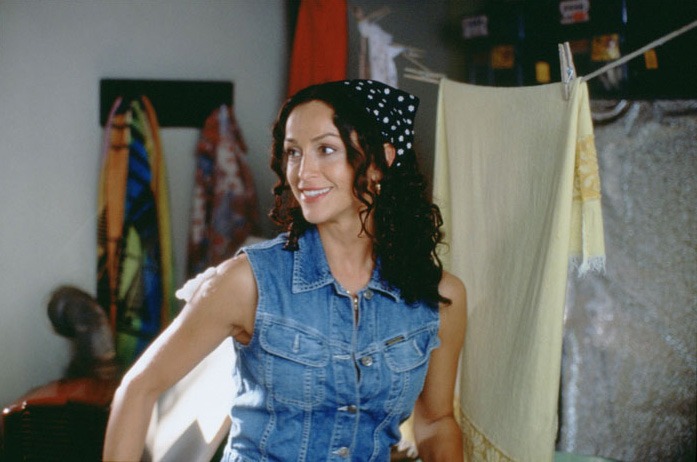
Writing Passion
Written by Sandy MacDonald | Posted by: Anonymous
"Passionada," a multigenerational love story set in the Portuguese-American community of New Bedford, Massachusetts, debuts at a gala on August 4 at the city’s Flagship Cinema to kick off the film’s nationwide theatrical release on August 15. The first major film shot in New Bedford since the 1922 silent classic "Down to the Sea in Ships" starring a young Clara Bow, it makes the most of a unique and vibrant culture. The film tells the story of Celia Amonte, a young widow whose fisherman husband died at sea, and her struggle to move on and risk loving once again.
NewEnglandFilm.com caught up with writer Steve Jermanok, a prolific Boston-based travel writer, fresh from a "media blitz" in New York and LA.
SM: The odds of a fledgling screenwriter getting a film not only made, but also widely released must be a zillion to one. What factors would you say account for your success?
Jermanok: Yes, I wouldn’t want to know the real odds. When my brother Jim and I entered into an agreement with the producer David Bakalar to write this script, all we wanted to do was create the best possible product — to write a highly original story with compelling characters. We were fortunate to base the script in New Bedford, one of the few places on the Eastern seaboard that has yet to be gentrified. No Ann Taylors or Gaps in a seaside mall, a la Quincy Market — just working fishermen mending their nets next to their fleet. Add the cobblestone streets and the whaling history that Melville discussed in "Moby Dick" and you have a backdrop rich with cinematic potential. The thriving Portuguese community along Acushnet Street and their sweetbread bakeries and small cafes serving up kale soup and bacalhao enhance the international appeal. The seeds were planted. All we had to do was add water.
SM: I gather that the producer (and angel) David Bakalar had started his own script before he turned to you and your brother. How much of his original concept was retained?
Jermanok: I wouldn’t say he had a script, just random notes with characters who could be included. He wanted a story set in New Bedford with a single mother and daughter. We made the daughter significantly older and the mother widowed. He also wanted the mother to meet someone outside of the Portuguese community who was a bit slick and not very trustworthy. We’ve included that aspect as well.
Bakalar noted that if he liked the script, he would invest in the movie. We were overjoyed that he wanted to push onward. We hired a director we admire, Dan Ireland, who’s best known for a movie on the pulp fiction writer behind Conan the Barbarian, called "The Whole Wide World" (starring Renee Zelwegger before she went on to make "Jerry Maguire" with Tom Cruise). Ireland somehow made the dusty barren landscape of Texas look inviting in the film. We thought he could do wonders with the gritty seaport of New Bedford.
Ireland read the script and was on a flight to Boston within the week. Contracts signed, he hired a stellar crew, including Mexican cinematographer Claudio Rocha, who worked on "Like Water for Chocolate," and Austin-based art director John Frick, who had a keen eye for the whimsy.
The cast includes the prolific Seymour Cassel, best known for his work on John Cassavetes films, Theresa Russell ("Black Widow"), Lupe Ontiveros ("Chuck and Buck," "Real Women Have Curves"), Emmy Rossum (soon to be the female lead in Joel Schumacher’s "Phantom of the Opera"), Jason Isaacs (he plays Lucius Malfoy in the latest "Harry Potter"), and Sofia Milos (from "Sopranos" and "CSI: Miami").
Cast and crew lived up to their billing. We added a remarkable score by Harry Gregson-Williams ("Shrek") and well, the rest is history. The film first showed in June 2002 at the Seattle International Film Festival, where it created a buzz, and IDP Films picked up distribution shortly afterwards.
SM: Was this a first outing for you, or had you worked on screenplays before? Also, what is your brother’s background?
Jermanok: This is the sixth script my brother and I have collaborated on. Other scripts include "High Moon," a satirical take-off of "High Noon" for the Academy-Award winning producer of "Babette’s Feast," Just Betzer; and a sophisticated comedy, "Happy Anniversary," optioned by a British producer. We plan to direct this one in the spring of 2004. Jim also wrote a 30-minute film, "Clear Cut," starring Calista Flockhart and Stephen Fry.
Jim comes from the world of theater. He has directed 15 professional and regional productions ranging from "G.R. Point to Rosencrantz and Guildenstern are Dead." His latest directorial effort, "The Tramway End", was presented for three months at the Chelsea Playhouse in New York.
Jim was an agent at International Creative Management for eight years. Like many people in the world of entertainment, he started in the mailroom. Within a year, he was promoted to a full-fledged agent at the age of 25. He represented such clients as Isabel Allende, Alan Arkin, Roy Blount Jr., T. Coraghessan Boyle, John Chancellor, E.L. Doctorow, Lou Gossett Jr., Spalding Gray, Helen Hayes, Bill Irwin, Thomas Keneally, Burt Lancaster, Shirley MacLaine, Arthur Miller, Dudley Moore, Harry Reasoner, Cliff Robertson, Andy Rooney, General H. Norman Schwartzkopf and Henry Winkler, among others.
SM: Tell me some specifics of your working method. Did you bounce things back and forth, and how? Were you on the set once it started shooting, doing rewrites? What or who precipitated the revised ending, and how did that go?
Jermanok: By far the most arduous part of writing the script is doing the story treatment. While the actual screenplay might take three to four weeks to write, thinking up a decent story with intriguing characters can take months. Jim, who lives in Astoria, Queens, makes the sacrifice of visiting me in suburban Boston to sculpt the story. We go on walks, work out with elderly Russian men at the local gym, spend hours sucking down varieties of cappuccinos at Starbucks. Yes, we bounce around ideas, argue with each other, and laugh like teenagers, as only siblings can do. Eventually, we agree on different plot points and start pounding away at the keys.
Obviously, the script is incredibly organic, with every creative mind on the set feeding into it. Dan Ireland had his revisions, as did many of the actors. Most of those were mere changes of lines, not major story restructuring. Nothing was set in stone until the scene was filmed.
One aspect of the third act some audience members in Seattle and at focus groups found to be too violent, so we revised that scene to blend better with the genre of the film, a romantic comedy. We created a whole new sequence and the cast and crew had to come to back to New Bedford to re-film.
SM: I get the impression you poked around New Bedford quite a bit before formulating the script. What kinds of discoveries influenced the direction it took?
Jermanok: As you know, I fool around in the world of travel writing as well. Jim is also a world traveler. Together, we’ve visited over 100 countries. When we went to New Bedford the first time, we took it like any travel writing assignment: met the locals, tried the food, listened to the music, spent hours watching and talking to the fishermen. We would taste the sweetbread, have far too much of the salted cod. Many of these items, like the food, figure prominently in "Passionada." Arguably, our greatest discovery was finding the haunting melancholy sound of Fado music at a bar one night in nearby Fall River. Mesmerized by the sound, we had to include this in the film. It propelled the story in a powerful new direction.
For more information about 'Passionada,' visit www.passionada.com.










